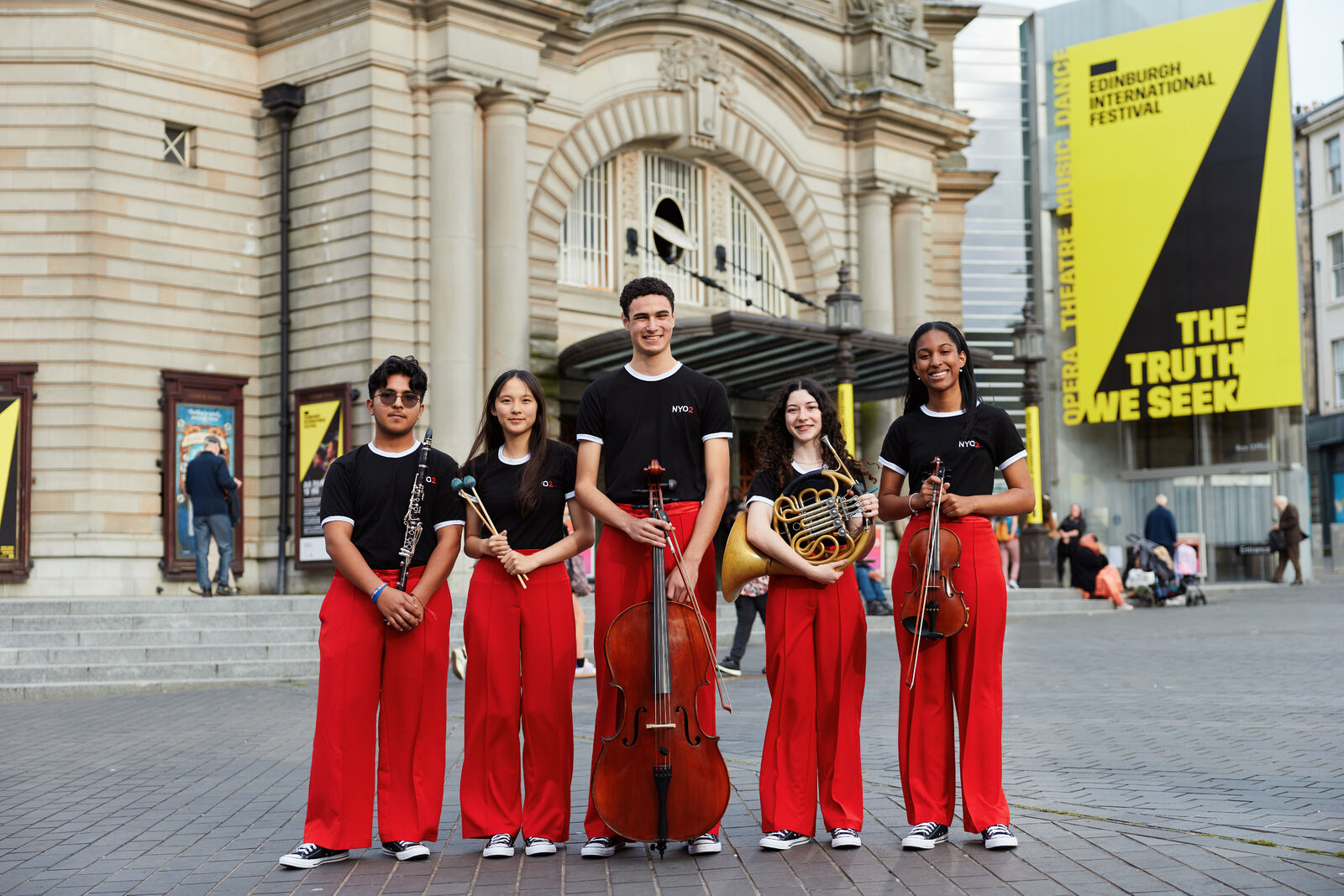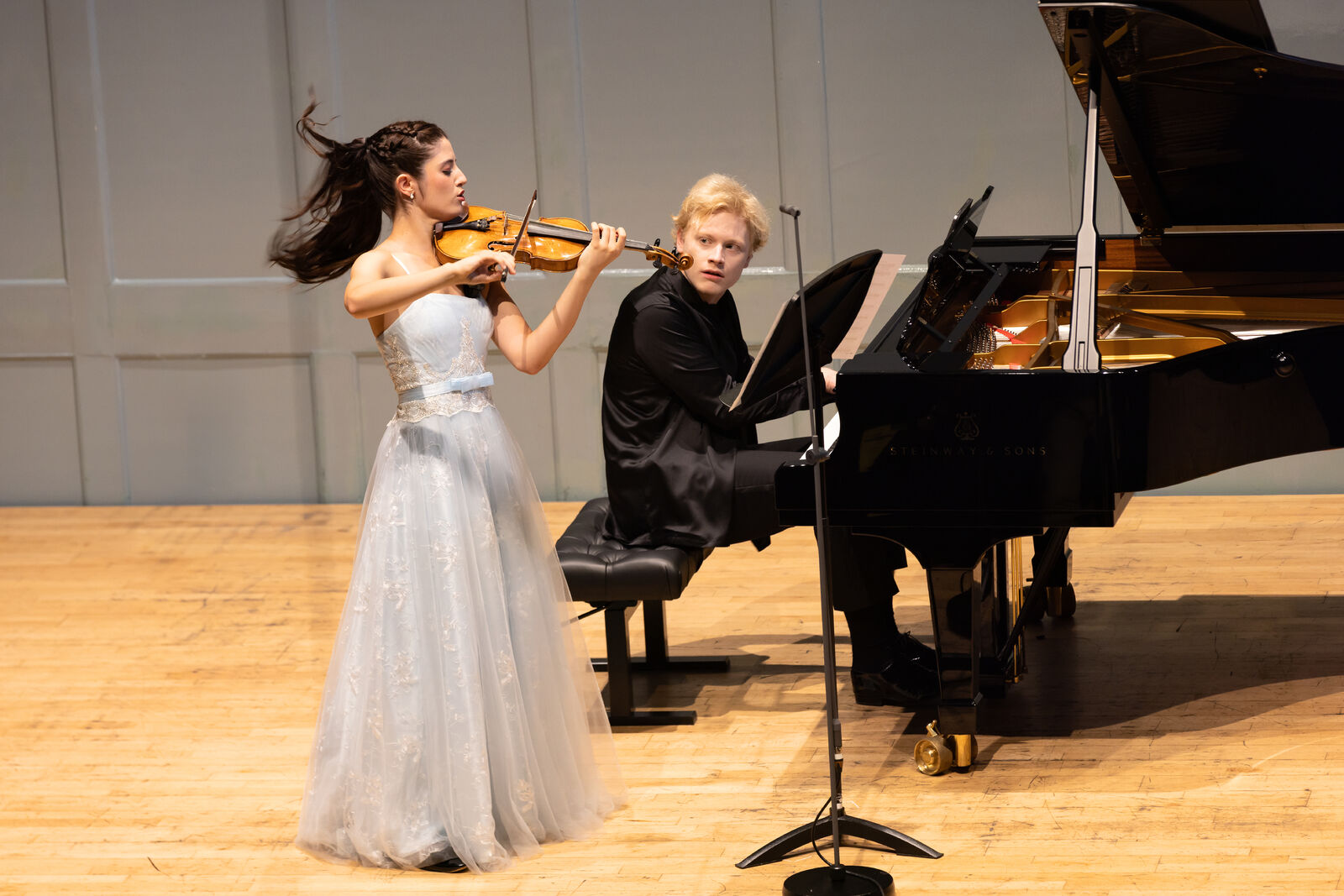Weilerstein, NYO2, Payare / Dueñas, Malofeev, Edinburgh International Festival 2025 review - youthful energy and emotional intensity | reviews, news & interviews
Weilerstein, NYO2, Payare / Dueñas, Malofeev, Edinburgh International Festival 2025 review - youthful energy and emotional intensity
Weilerstein, NYO2, Payare / Dueñas, Malofeev, Edinburgh International Festival 2025 review - youthful energy and emotional intensity
Big-boned Prokofiev and Shostakovich, cacophonous López, plus intense violin/piano duo

NYO2 is a group of dazzlingly talented (and terrifyingly young-looking) 14-17 year olds from the USA, one of Carnegie Hall’s three national youth ensembles, and with a focus on supporting young musicians from communities that are under-represented in the arts. This Edinburgh International Festival concert marked their European debut, and they’re doing a miniature residency in Edinburgh that, in another concert, involves them playing alongside some talented young Scots.
Whatever their age, they can certainly play. Perhaps the only concession to their inexperience came from conductor Rafael Payare, whose beat was exceptionally clear and easy to follow in Jimmy López’s Perú Negro. The orchestra lavished confident playing on López’s piece, even if it was too thin to really merit it. Its open fanfares, spooky walking bass and dancing syncopations felt a bit formulaic, for all that its edgy viola tune was played with vigour, and ultimately it felt like several layers of sound trowelled together rather than a coherent whole. Still, it had its fair share of cacophonous outbursts, which is exactly the sort of thing youth orchestras are supposed to be good at (pictured below, members of NYO2 outside the Usher Hall).  They’re also good at big tunes and open soundscapes, which made Prokofiev’s Symphony No. 5 a good fit for them. Here they really got the chance to showcase their sound, with gleaming trumpets shining atop foundational trombones and tuba, with rich, full strings and winds that could sing with cantabile sweetness when required. The clarinets were terrific in the Trio sections of the Scherzo, and when everyone pulled out the stops there was an exhilarating, almost intimidating sense of weight to the climactic sequence of the first movement. Payare kept everything moving purposefully, finding moments of transparency even in the overwrought Adagio, and he collaborated nicely with the musicians to produce a sense of encroaching anarchy in the finale.
They’re also good at big tunes and open soundscapes, which made Prokofiev’s Symphony No. 5 a good fit for them. Here they really got the chance to showcase their sound, with gleaming trumpets shining atop foundational trombones and tuba, with rich, full strings and winds that could sing with cantabile sweetness when required. The clarinets were terrific in the Trio sections of the Scherzo, and when everyone pulled out the stops there was an exhilarating, almost intimidating sense of weight to the climactic sequence of the first movement. Payare kept everything moving purposefully, finding moments of transparency even in the overwrought Adagio, and he collaborated nicely with the musicians to produce a sense of encroaching anarchy in the finale.
But the evening’s highlight came thanks to Mrs Payare, aka Alisa Weilerstein, who gave a performance of Shostakovich’s First Cello Concerto that balanced staccato playfulness with keening emotional involvement. The first movement seemed to thumb its nose at anyone who cared to be watching, while the Moderato second movement quivered with emotional intensity, formidably focused, leading into a cadenza that was unafraid to take its time, with some daringly elongated pauses along the way. The orchestra responded with outer movements that were light on their feet, caught up in the whirl of frenetic energy but sounding surprisingly sensual at times, the strings bringing powerful desperation to the slow movement.  Playing of similar emotional intensity, albeit on a much smaller scale, was on display the following morning in the Queen’s Hall, with a recital from Spanish violinist María Dueñas and Russian pianist Alexander Malofeev (pictured above by Jess Shurte). Between the two of them, they could fit together like hand in glove, or contrast like Mediterranean fire and Arctic ice. In Franck’s Violin Sonata, for example, they had a gorgeous cantabile air to the whole thing. In a work where the piano and violin have such different lines that they can sound as though they’re playing past one another, here the two instruments sounded as though they were duetting as in a love song, and they never lost sight of the fact that this work was, after all, a love gift: a wedding present to its first performer, star violinist (and Franck’s compatriot) Eugène Ysaÿe. Glorious lyricism and gorgeous beauty of tone surged through every line, the graceful finale sounding like the embodiment of ease and elegance.
Playing of similar emotional intensity, albeit on a much smaller scale, was on display the following morning in the Queen’s Hall, with a recital from Spanish violinist María Dueñas and Russian pianist Alexander Malofeev (pictured above by Jess Shurte). Between the two of them, they could fit together like hand in glove, or contrast like Mediterranean fire and Arctic ice. In Franck’s Violin Sonata, for example, they had a gorgeous cantabile air to the whole thing. In a work where the piano and violin have such different lines that they can sound as though they’re playing past one another, here the two instruments sounded as though they were duetting as in a love song, and they never lost sight of the fact that this work was, after all, a love gift: a wedding present to its first performer, star violinist (and Franck’s compatriot) Eugène Ysaÿe. Glorious lyricism and gorgeous beauty of tone surged through every line, the graceful finale sounding like the embodiment of ease and elegance.
In Debussy’s sonata, on the other hand, sparkles of ice from the piano balanced measured, mellow richness from the violin. Both trod a path of filigree delicacy through the central Intermède, while the finale balanced scampering animation with stalking darkness. Maybe Szymanowski’s sonata hung together slightly less well, but it’s a less substantial work, and Dueñas’ violin line still surged with rich passion and sensuous beauty through the music’s fragmented textures.
rating
Share this article
The future of Arts Journalism
You can stop theartsdesk.com closing!
We urgently need financing to survive. Our fundraising drive has thus far raised £49,000 but we need to reach £100,000 or we will be forced to close. Please contribute here: https://gofund.me/c3f6033d
And if you can forward this information to anyone who might assist, we’d be grateful.

Subscribe to theartsdesk.com
Thank you for continuing to read our work on theartsdesk.com. For unlimited access to every article in its entirety, including our archive of more than 15,000 pieces, we're asking for £5 per month or £40 per year. We feel it's a very good deal, and hope you do too.
To take a subscription now simply click here.
And if you're looking for that extra gift for a friend or family member, why not treat them to a theartsdesk.com gift subscription?
more Classical music
 Jansen, LSO, Pappano, Barbican review - profound and bracing emotional workouts
Great soloist, conductor and orchestra take Britten and Shostakovich to the edge
Jansen, LSO, Pappano, Barbican review - profound and bracing emotional workouts
Great soloist, conductor and orchestra take Britten and Shostakovich to the edge
 Jakub Hrůša and Friends in Concert, Royal Opera review - fleshcreep in two uneven halves
Bartók kept short, and a sprawling Dvořák choral ballad done as well as it could be
Jakub Hrůša and Friends in Concert, Royal Opera review - fleshcreep in two uneven halves
Bartók kept short, and a sprawling Dvořák choral ballad done as well as it could be
 Hadelich, BBC Philharmonic, Storgårds, Bridgewater Hall, Manchester review - youth, fate and pain
Prokofiev in the hands of a fine violinist has surely never sounded better
Hadelich, BBC Philharmonic, Storgårds, Bridgewater Hall, Manchester review - youth, fate and pain
Prokofiev in the hands of a fine violinist has surely never sounded better
 Monteverdi Choir, ORR, Heras-Casado, St Martin-in-the-Fields review - flames of joy and sorrow
First-rate soloists, choir and orchestra unite in a blazing Mozart Requiem
Monteverdi Choir, ORR, Heras-Casado, St Martin-in-the-Fields review - flames of joy and sorrow
First-rate soloists, choir and orchestra unite in a blazing Mozart Requiem
 Cho, LSO, Pappano, Barbican review - finely-focused stormy weather
Chameleonic Seong-Jin Cho is a match for the fine-tuning of the LSO’s Chief Conductor
Cho, LSO, Pappano, Barbican review - finely-focused stormy weather
Chameleonic Seong-Jin Cho is a match for the fine-tuning of the LSO’s Chief Conductor
 Classical CDs: Shrouds, silhouettes and superstition
Cello concertos, choral collections and a stunning tribute to a contemporary giant
Classical CDs: Shrouds, silhouettes and superstition
Cello concertos, choral collections and a stunning tribute to a contemporary giant
 Appl, Levickis, Wigmore Hall review - fun to the fore in cabaret and show songs
A relaxed evening of light-hearted fare, with the accordion offering unusual colours
Appl, Levickis, Wigmore Hall review - fun to the fore in cabaret and show songs
A relaxed evening of light-hearted fare, with the accordion offering unusual colours
 Lammermuir Festival 2025, Part 2 review - from the soaringly sublime to the zoologically ridiculous
Bigger than ever, and the quality remains astonishingly high
Lammermuir Festival 2025, Part 2 review - from the soaringly sublime to the zoologically ridiculous
Bigger than ever, and the quality remains astonishingly high
 BBC Proms: Ehnes, Sinfonia of London, Wilson review - aspects of love
Sensuous Ravel, and bittersweet Bernstein, on an amorous evening
BBC Proms: Ehnes, Sinfonia of London, Wilson review - aspects of love
Sensuous Ravel, and bittersweet Bernstein, on an amorous evening
 Presteigne Festival 2025 review - new music is centre stage in the Welsh Marches
Music by 30 living composers, with Eleanor Alberga topping the bill
Presteigne Festival 2025 review - new music is centre stage in the Welsh Marches
Music by 30 living composers, with Eleanor Alberga topping the bill
 Lammermuir Festival 2025 review - music with soul from the heart of East Lothian
Baroque splendour, and chamber-ensemble drama, amid history-haunted lands
Lammermuir Festival 2025 review - music with soul from the heart of East Lothian
Baroque splendour, and chamber-ensemble drama, amid history-haunted lands
 BBC Proms: Steinbacher, RPO, Petrenko / Sternath, BBCSO, Oramo review - double-bill mixed bag
Young pianist shines in Grieg but Bliss’s portentous cantata disappoints
BBC Proms: Steinbacher, RPO, Petrenko / Sternath, BBCSO, Oramo review - double-bill mixed bag
Young pianist shines in Grieg but Bliss’s portentous cantata disappoints

Add comment